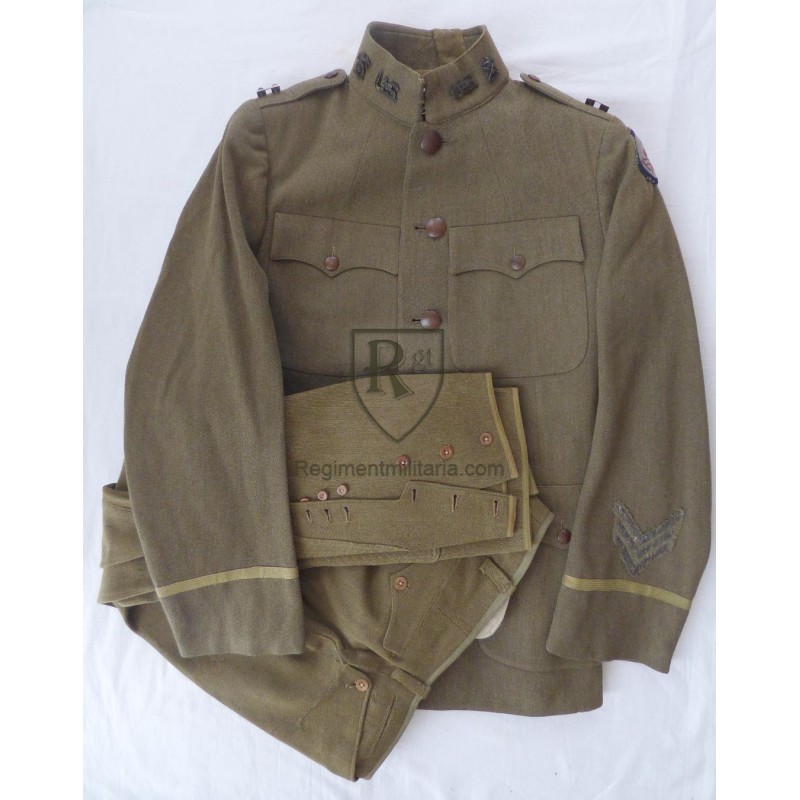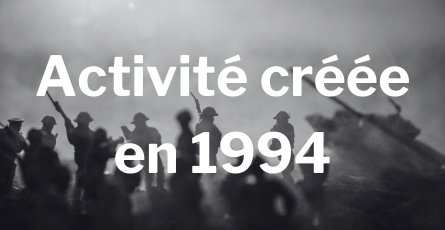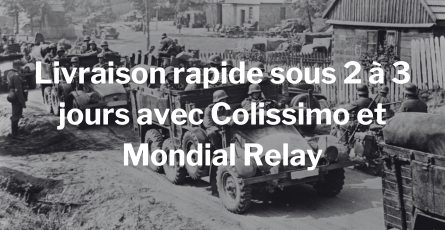- Out-of-Stock

Banner

Banner




















1908 Officer's uniform Advanced Sector Service of Supply.
 Garanties sécurité
Garanties sécurité
(à modifier dans le module "Réassurance")
 Politique de livraison
Politique de livraison
(à modifier dans le module "Réassurance")
 Politique retours
Politique retours
(à modifier dans le module "Réassurance")
Original U.S. WWI AEF Officer's Advance Sector Service of Supply uniform. Very nice jacket with New York tailor tab, Officer's breeches with moth damages.
Very nice set.
This uniform and helmet both feature the Advance Sector, SOS insignia which is comprised of the French cross of Lorraine, flanked by the initials 'A' and 'S' in red. The uniform insignia is on a white wool background surrounded by a blue ring.The 'Advance Sector, Service of Supply' and was worn primarily by members of the Quartermaster Corps.
AEF supplies destined for the Doughboys at the front were funneled through a series of depots and installations located at key points along the 'Lines of Communication' (LOC). The LOC was divided into the 'Base Sector', the 'Intermediate Sector' and the 'Advance Sector'. The journey began at the large base depots established in the French port cities of St. Nazarie, Le Harve, Brest, La Pallice and later Marsaeilles. There, the cargo was unloaded from the transport ships and housed in huge warehouses. Troops posted to the Base Sectors would have worn the Service of Supply or SOS shoulder sleeve insignia (SSI).
The supplies were then moved in wholesale lots from the massive base depots, up to an Intermediate Depot which was located closer to the front. The Intermediate Depot was the replenishing point for the Advanced Depots further up the line. It was also where the AEF supplies which had been shipped in bulk were broken down, sorted and repacked before being sent forward. Men
working at the Intermediate Sectors world have worn the Intermediate Sector, Service of Supply SSI.
These Advance Depots which were also known as 'Regulating Stations' were always located near a main rail line. The forward depots were better equipped for the rapid movement of large amounts of equipment and supplies that were requisitioned by daily telegrams from the line units at the front. Nothing passed through the Regulating Stations without first being ordered. This included every soldier going to or returning from leave areas, schools and hospitals. It also included replacements moving up to the front (both men and animals), rations, ingoing and outgoing mail, socks, gasmasks and every other piece of fighting equipment intended for soldiers fighting at the front; with the exception of weapons and ammunition which was shipped separately by the Ordnance Department. The Advance Depots organized returning men and replacement animals by division, and resorted and repacked the requested supplies onto rail cars for daily transportation to each division's railhead. The soldiers stationed at the Advance Sectors would have worn the Advance Sector, Service of Supply SSI.
In many instances, Advance Sector personnel also transported Army, Corps and Division supplies further forward, up to their respective supply dumps. Army Supply Dumps were usually located 10 to 12 miles behind the lines; Corps Supply Dumps were situated some 10 to 6 miles to the rear of the fighting; while the Division Supply Dumps were the closest, at just 4 or 5 miles behind the front lines. It was at these supply dumps where the men, animals and supplies were passed over to the control of divisional Quartermaster and Supply Train personnel for delivery to the troops in the trenches.
The supplies were again broken down and resorted based on the needs of each organization within the division. Usually everything would be loaded onto motor trucks which carried the men and equipment as far as the shell ravaged roads permitted. When the trucks could go no further, the supplies were transferred to mule and horse drawn wagons and carts to continue the journey under cover of darkness. Pack mules and carrying parties often finished the task of getting the supplies up to the firing line.
The "Advance", "Intermediate" and "Base" Sectors were all separate commands within the AEF. Each of which encompassed a specific area of geography that was located behind the "Zone of Advance". The borders of those three sectors were in a constant state of flux depending on the ebb and flow of combat at the front.
The personnel permanently posted to those sectors were generally support troops composed of Engineer, Quartermaster, Medical, Signal Corps, Military Police, Motor Transport, Ordnance and other personnel. Collectively, these troops composed the personnel of each respective sector and wore the appropriate shoulder patch. However, a number of units (both large & small) within the various sectors adopted an unofficial shoulder insignia that was unique to their particular organization, and wore that instead of the shoulder insignia that had been prescribed by the AEF.
In other words, the Advance Sector shoulder patch was not worn by a single branch of military service or by a single military outfit. It was worn by a wide variety AEF organizations, each of which specialized in supporting the front line combat units. Therefore the men from a butcher's outfit at a cold storage plant - laborers from a stevedore regiment - engineers operating a sawmill - mechanics at a motor park - doctors and nurses at a base hospital - supply clerks at a warehouse, etc
This uniform of the Advance Sector,
Reference: U2E790
Reference: F1E467
Reference: SE009
Reference: U2E728
Reference: U2E637
Reference: FEM032

1908 Officer's uniform Advanced Sector Service of Supply.
check_circle
check_circle